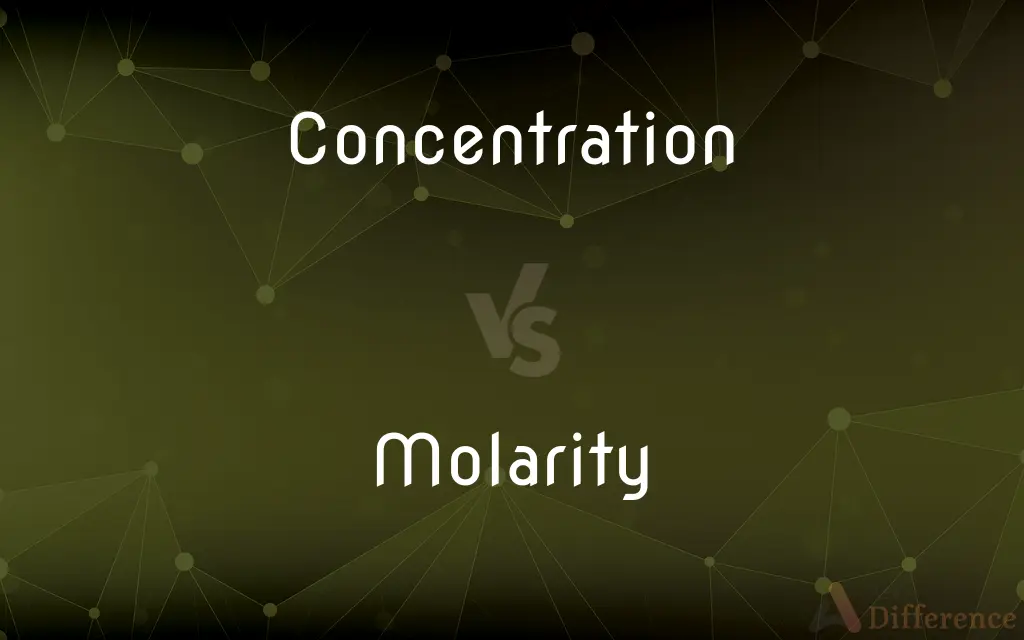Concentration vs. Molarity — What's the Difference?
Edited by Tayyaba Rehman — By Maham Liaqat — Updated on April 15, 2024
Concentration describes the amount of a substance in a mixture, generally; molarity is a specific measure of concentration in moles per liter.

Difference Between Concentration and Molarity
Table of Contents
ADVERTISEMENT
Key Differences
Concentration is a broad term used to define the amount of one substance dissolved in another, regardless of the measurement units. Whereas, molarity specifically measures concentration using moles of solute per liter of solution, providing a standardized unit in chemical contexts.
While concentration can be expressed in various units such as mass per volume, percentage, or parts per million, molarity is exclusively expressed in moles per liter (mol/L), which is useful for stoichiometric calculations in chemistry.
Concentration offers a general understanding of solute quantity in a solution, useful in various scientific and industrial applications. On the other hand, molarity is particularly important in chemical reactions and formulae, where precise mole ratios are necessary.
In practical terms, when you adjust the volume of a solution, concentration can change in terms depending on the unit used. Molarity, however, directly changes with volume, as it is tied specifically to the volume of the solution in liters.
Understanding concentration is vital in fields like pharmacology and environmental science, where various units are used to meet specific needs. Molarity serves as the standard unit in most chemical laboratories for preparing solutions and conducting experiments.
ADVERTISEMENT
Comparison Chart
Definition
Quantity of solute in a given quantity of solvent or solution.
Number of moles of solute per liter of solution.
Units
Varied (e.g., mg/mL, %, ppm)
Moles per liter (M/L)
Usage
Broad applications across sciences and industries.
Primarily used in chemistry and biochemistry.
Dependence on Volume
Depends on the unit used; not always direct.
Directly proportional to changes in solution volume.
Calculation Relevance
Useful for general measurements and non-chemical applications.
Essential for stoichiometric calculations in reactions.
Compare with Definitions
Concentration
Varies by industry in terms of preferred units.
Environmental scientists measure pollutant concentration in ppm.
Molarity
Standard in preparing laboratory solutions.
Molarity is crucial for the accurate preparation of chemical reagents.
Concentration
The proportion of solute in a solution.
A high concentration of salt can be observed in seawater.
Molarity
A unit of concentration in moles per liter.
The solution’s molarity was 1 mol/L.
Concentration
Can be expressed as mass per volume.
The concentration of sugar was 10g per 100mL.
Molarity
Directly changes with solution volume.
Diluting the solution halves the molarity.
Concentration
Often used in medical dosing.
The medication has a concentration of 2mg per mL.
Molarity
Necessary for precise chemical calculations.
Titration requires exact molarity measurements for accuracy.
Concentration
Impacts the physical properties of solutions.
Concentration affects the boiling point of solutions.
Molarity
Used to calculate reactant ratios.
To balance the equation, the molarity of each reactant must be considered.
Concentration
In chemistry, concentration is the abundance of a constituent divided by the total volume of a mixture. Several types of mathematical description can be distinguished: mass concentration, molar concentration, number concentration, and volume concentration.
Molarity
Abbr. M The concentration of a solution expressed in moles of solute per liter of solution.
Concentration
The action or power of focusing all one's attention
She was frowning in concentration
Molarity
(chemistry) the concentration of a substance in solution, expressed as the number of moles of solute per litre of solution
Concentration
A close gathering of people or things
The island has the greatest concentration of seabirds in the north-west
Molarity
Concentration measured by the number of moles of solute per liter of solvent
Concentration
The relative amount of a particular substance contained within a solution or mixture or in a particular volume of space
The gas can collect in dangerous concentrations
Concentration
The act or process of concentrating, especially the fixing of close, undivided attention.
Concentration
The condition of being concentrated.
Concentration
Something that has been concentrated.
Concentration
(Chemistry) The amount of a specified substance in a unit amount of another substance.
Concentration
The act, process or ability of concentrating; the process of becoming concentrated, or the state of being concentrated.
Concentration
The direction of attention to a specific object.
Concentration
The act, process or product of reducing the volume of a liquid, as by evaporation.
Concentration
The act or process of removing the dress of ore and of reducing the valuable part to smaller compass, as by currents of air or water.
Concentration
A field or course of study on which one focuses, especially as a student in a college or university.
Concentration
The proportion of a substance in a whole.
Concentration
(chemistry) The amount of solute in a solution measured in suitable units (e.g., parts per million (ppm))
Concentration
The matching game pelmanism.
Concentration
The act or process of concentrating; the process of becoming concentrated, or the state of being concentrated; concentration.
Concentration of the lunar beams.
Intense concetration of thought.
Concentration
The act or process of reducing the volume of a liquid, as by evaporation.
The acid acquires a higher degree of concentration.
Concentration
The act or process of removing the dress of ore and of reducing the valuable part to smaller compass, as by currents of air or water.
Concentration
The strength of a solution; number of molecules of a substance in a given volume (expressed as moles/cubic meter)
Concentration
The spatial property of being crowded together
Concentration
Strengthening the concentration (as of a solute in a mixture) by removing extraneous material
Concentration
Increase in density
Concentration
Complete attention; intense mental effort
Concentration
Bringing together military forces
Concentration
Great and constant diligence and attention
Common Curiosities
Why is molarity important in chemistry?
It allows chemists to relate quantities of reactants and products in a reaction stoichiometrically.
Is concentration the same as molarity?
No, concentration is a general term, while molarity is a specific measurement under concentration.
What is concentration in chemistry?
It’s the measure of how much solute is present in a given amount of solvent or solution.
Can concentration be expressed in terms of molarity?
Yes, molarity is a specific way to express concentration in terms of moles per liter.
Are there other ways to express concentration besides molarity?
Yes, concentration can also be expressed as mass/volume, percentage, or parts per million.
What is molarity and how is it calculated?
Molarity is the number of moles of a solute per liter of solution. It's calculated as moles of solute divided by liters of solution.
Why might a pharmacist use concentration rather than molarity?
Pharmacists use concentration for dosing, often in mg/mL, which is more relevant for medical applications.
How do changes in solution volume affect molarity and concentration?
Molarity directly changes with the volume of the solution, while other forms of concentration might not be directly proportional.
What units are used for concentration?
Units like grams per liter, percentage, and parts per million are commonly used.
Which is more precise, molarity or general concentration measurements?
Molarity offers more precision for chemical reactions due to its basis in moles and liters.
How do environmental scientists use concentration?
They often measure pollutant levels in parts per million or billion to assess environmental quality.
How do you convert percentage concentration to molarity?
Convert the percentage to a mass/volume concentration first, then use the molar mass to find the molarity.
What role does molarity play in titration?
Molarity helps determine the precise amount of titrant needed to reach the equivalence point in a titration.
What is the most common unit of concentration in food science?
Percentage is commonly used in food science to describe ingredients and nutrients.
What is an example of a concentration that is not molarity?
A saline solution with 0.9% sodium chloride is an example of a concentration not expressed as molarity.
Share Your Discovery

Previous Comparison
Angle vs. Slope
Next Comparison
Chalk vs. CharcoalAuthor Spotlight
Written by
Maham LiaqatEdited by
Tayyaba RehmanTayyaba Rehman is a distinguished writer, currently serving as a primary contributor to askdifference.com. As a researcher in semantics and etymology, Tayyaba's passion for the complexity of languages and their distinctions has found a perfect home on the platform. Tayyaba delves into the intricacies of language, distinguishing between commonly confused words and phrases, thereby providing clarity for readers worldwide.
















































